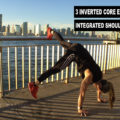Hops, bounds, and jumps are all methods that build explosive strength in the lower body in order to maximally transfer forces across the ground efficiently, effectively and with POWER. Good for rehab? General fitness? Sports? YES. Let’s find out why…
KEY POINTS:
Uncover the difference between Jump, Hop, and Bound.
Hopping can be used as a performance measure of function as well as a screening for injury risk potential.
You must learn how to LAND, BEFORE you can even think about leaving the ground.
Speed is a progression. You must EARN the right to go fast, by first going slow.
HOP vs BOUND vs JUMP
Hop – take off on the right, land on the right.
Bound/Leap – take off on the right, land on the left.
Jump – take off on two legs, land on two legs.
.
USE IN ASSESSMENT & TRAINING
These locomotor patterns have a few important things in common.
They are fundamental pre-requite movements utilized in sports training and rehabilitation programing.
They are essential tools for assessing explosive leg strength and power, postural stability, and neuromuscular control at the hip, knee and ankle.
And lately, all three are showing up more frequently in group fitness classes.
In a clinical physical therapy setting, we routinely use the Hop Tests to assess leg strength and power, and to predict limb strength and athlete readiness after knee surgery. As someone who is a 3x ACL-reconstructed champ, these movements make great post-op recovery tools, AND also double as an essential part of ongoing conditioning and performance training.
Whether you work with clients one-on-one or in large groups, you can utilize the hop, bound, jump:
- As an assessment tool to identify deficits (and improvements) in performance or risk potential for future injury
- Discover if asymmetries and imbalances exist from limb to limb
- As training tools for superior dynamic stability and control at the ankle, knee and hip
- To build explosive strength and starting strength that is sport specific and life specific! Pop them right into any training session for big returns
BUT FIRST….
In this article I talked about the importance of assessments in group fitness programs. In order to prevent injury and improve performance using these movements, you must first ensure that the strength, balance, and control (both statically and dynamically) are symmetrical from right to left. The specific assessment testing protocols are beyond the scope of this article; just do a search for “hop tests” and dive right into the literature.
But in general, test the hop and look for glaring differences in form, from limb to limb. Test hopping in place, side to side, and hopping for distance ( 00:06 in the video.) The client should be able to land with a hinge at the hip, slight bend in the knee, and a stable and slight forward lean of the trunk.
Look for any of the following compensations:
Excessive pronation
Knee valgus
“Trandelenburg” (drop pelvis on the landing side)
Inability to stabilize the trunk over the landing leg
.
TAKE-OFF AND LANDING SHOULD LOOK THE SAME
All too often we can get caught up in the take off, the height, or the distance of the jump/hop/bound, that we forget to focus on perhaps the MOST CRITICAL phase of the movement – the LANDING.
A wise woman (me) once said “You MUST learn how to land, BEFORE you can even think about leaving the ground.” So if you are working with clients, make them master the landing, before progressing any variable of a the movement pattern.
The landing form is typically a bent knee, hinged hip, and a moderate amount of forward trunk lean. These mechanics allow for appropriate absorption of the forces while ensuring the proper orientation for maximal force production necessary to get to the next jump/hop/bound.
JUMP LANDING – HINGE or SQUAT?
When working with clients on jumping in sagital plane (00:15 in the video), frontal or transverse plane (00:19 in the video), it is crucial to express which landing form you are after, the shallow hinge or the full squat. The choice of landing should be based on your desired outcome for the exercise as well as and client centered goals.
DON’T FORGET TO “STICK IT”
Most people skip the final stabilization phase of each of these moves. SO before you may even consider doing any of these quickly, or even adding a burpee or stacking another move on top, you must be able to stick the landing good form.
Speed is a progression and when used inappropriately, it will ALWAYS cover up asymmetries in strength and balance.
You must EARN the right to go fast, by first going slow.
ADDING WEIGHT TO A JUMP? N.O.
In general, the older you are, the less you should consider adding weight to a jump, leap, or hop. Your joints (and your articulate cartilage) aren’t built for that kind of loading ESPECIALLY if you’re past the age of 25. There are too many links in the chain that can break down and increase the potential for injury. The GOOD NEWS is that there are SO many progressions to earn before one should ever consider jumping with added resistance.
Consider the following variables as progressions: Height, distance, limb choice, pauses, tempo etc., to name a few.





